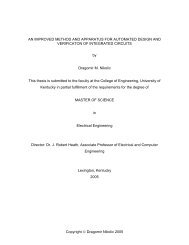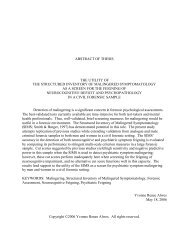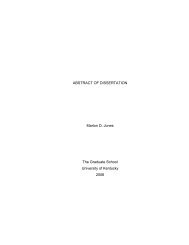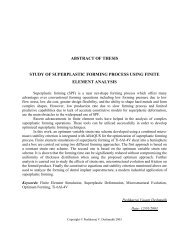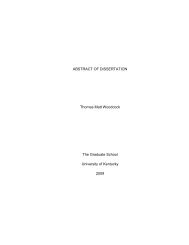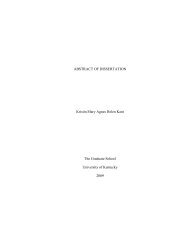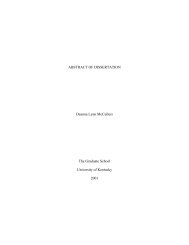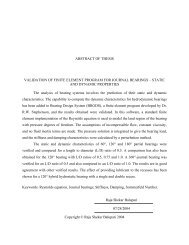Ambystoma - University of Kentucky Libraries
Ambystoma - University of Kentucky Libraries
Ambystoma - University of Kentucky Libraries
Create successful ePaper yourself
Turn your PDF publications into a flip-book with our unique Google optimized e-Paper software.
CHAPTER 1: Introduction.<br />
Genetic information from the salamander <strong>Ambystoma</strong> mexicanum, commonly known as<br />
the Mexican axolotl, provides unique on adaptation and the evolution <strong>of</strong> vertebrate<br />
genomes. The evolutionary history <strong>of</strong> A. mexicanum has suited it for these studies in two<br />
important ways. First, the species is a member <strong>of</strong> the class Amphibia. The amphibian<br />
lineage and the amniote lineage (collectively: mammals, birds, and other reptiles) shared<br />
a common ancestor approximately 350 million years ago. Comparisons between<br />
amphibian and amniote genomes can therefore reveal conserved features that are retained<br />
from the genome <strong>of</strong> their common ancestor. A second convenient feature <strong>of</strong> A.<br />
mexicanum is that it is a member <strong>of</strong> the tiger salamander species complex (sensu Shaffer,<br />
1984a), which is distributed across the southern half <strong>of</strong> North America and consists <strong>of</strong><br />
several closely related species that have adapted to exploit a variety <strong>of</strong> temporary and<br />
permanent aquatic habitats (Shaffer and McKnight, 1996). Coordinate with their diverse<br />
habitat use, tiger salamanders also exhibit extreme diversity in phenotype (Shaffer,<br />
1984b). Despite this phenotypic diversity, crosses between tiger salamander species<br />
typically result in the production <strong>of</strong> viable and fertile hybrid <strong>of</strong>fspring (reviewed by Voss<br />
and Shaffer, 1996). When these hybrids are mated, their <strong>of</strong>fspring segregate genotypes<br />
that are inherited from their parental species and phenotypic variation that is associated<br />
with these genotypes.<br />
<strong>Ambystoma</strong> mexicanum is by far the best-studied member <strong>of</strong> the tiger salamander<br />
species complex and has a long history as a model organism. It was originally brought<br />
into laboratory culture by Aguste Duméril in 1870 (Duméril, 1870; Smith, 1989). Since<br />
this time, the species has served as a model system for studying vertebrate development<br />
(Armstrong and Malacinski, 1989), hence its other handle – the laboratory axolotl. Until<br />
recently, however, extensive genetic analyses have been limited by several factors,<br />
including: an exceedingly large genome size <strong>of</strong> roughly 30 gigabases (Gb) (Licht and<br />
Lowcock, 1991), a relatively long generation time, and a relatively small number <strong>of</strong><br />
assayable genetic markers. That is not to say that genetic analyses are impossible for the<br />
species. In fact, my predecessors have succeeded in identifying phenotypes that segregate<br />
as Mendelian (single gene) factors (reviewed by Armstrong and Malacinski, 1989). Most<br />
critical among these are the discoveries that: 1) sex segregates as a Mendelian locus,<br />
7



